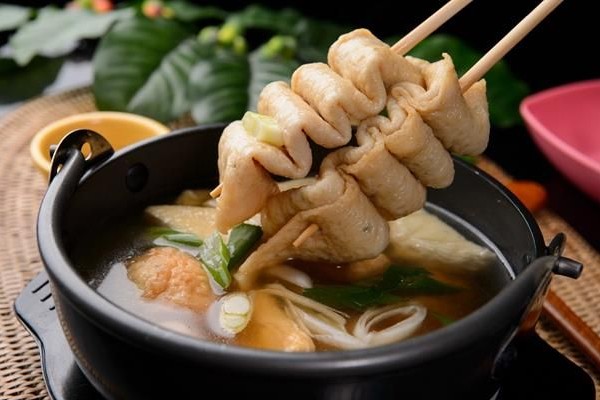Odeng: Korea’s Beloved Fish Cake
Odeng, also known as eomuk, holds a special place in the pantheon of Korean street foods. It is not merely a dish but a cultural symbol, capturing the essence of Korean comfort food with its simple yet satisfying flavors. This fish cake dish finds its origins in the Japanese kamaboko, yet it has undeniably been adapted into a uniquely Korean delight. Distinctively served on skewers and simmered in a delicious broth, odeng is omnipresent at street vendors across Korea, especially during the chilly seasons.
The Evolution and Cultural Significance of Odeng
Odeng first made its way to Korea during the Japanese occupation in the early 20th century. Despite its foreign origins, Koreans quickly embraced and adapted the recipe, infusing local flavors to create a product that resonated with their taste preferences. Over the years, odeng has evolved from a mere culinary adaptation to an indispensable part of Korea’s street food culture. It is not only favored for its taste but also for its role in social interactions, often enjoyed among friends or after a late night out. The communal aspect of sharing odeng, paired with its warm broth, provides comfort and warmth in the cold Korean winters, fostering a sense of community and belonging.
Ingredients and Preparation: The Making of Odeng
The primary ingredient in odeng is fish paste, made from white fish such as pollock or cod. The fish is finely ground, seasoned with salt, sugar, and monosodium glutamate to enhance flavor, and sometimes mixed with other ingredients like chopped vegetables or wheat starch for texture. This mixture is then shaped into various forms, commonly thin sheets or thick, round cakes. The traditional preparation involves skewering these cakes and boiling them in a flavorful broth made from kelp and anchovies. This broth not only imparts a rich umami flavor to the odeng but also serves as a popular soup to sip while enjoying the fish cakes.
Odeng in Modern Culinary Practices
In contemporary Korea, odeng continues to adapt to changing culinary trends and tastes. It can be found in various settings, from traditional street carts to upscale restaurants, showcasing its versatility. Modern variations of odeng include stuffing with cheese or wrapping in perilla leaves, adding new dimensions to the traditional flavor profile. Additionally, odeng is not limited to being served on skewers; it is also a popular ingredient in hot pots, stir-fries, and other hearty dishes. Its ability to absorb flavors makes it an excellent component in diverse recipes, proving its adaptability in Korean cuisine.
Nutritional Value and Health Benefits of Odeng
Odeng is not only tasty but also offers several health benefits, thanks to its main component—fish. It is a good source of high-quality protein, essential amino acids, and omega-3 fatty acids, which are beneficial for heart health and cognitive functions. Moreover, because it is processed and often includes various additives, it’s lower in fat compared to other fried street foods, making it a healthier option for those craving something savory. However, it is essential for consumers to consider the sodium content due to its seasoning and preparation in broth, which can be high.
Odeng Beyond Korea: Global Recognition
As Korean culture continues to captivate global audiences, odeng has also found its way onto the international culinary scene. Featured in Korean dramas and enjoyed by tourists visiting Korea, it has gained popularity mariatogel worldwide. International Korean markets and food festivals often feature odeng, allowing people from different backgrounds to experience this quintessential Korean snack. The dish’s simplicity, coupled with its comforting taste, has helped it transcend cultural and geographic boundaries, introducing people across the globe to a staple of Korean street food.
Innovations and Varieties: The Diverse World of Odeng
While odeng originally started as a simple fish cake boiled on a skewer, Korean creativity has given birth to a myriad array of variations that cater to every palate. From the spicy red pepper-flavored odeng to versions stuffed with cheese, the possibilities are endless. One popular innovation includes the ‘tteok-odeng,’ which combines chewy rice cakes with the savory fish cakes on a single skewer, offering a delightful texture contrast that is beloved by many. Seasonal varieties also appear, such as pumpkin odeng in the autumn, providing a sweet and earthy flavor that complements the traditional fish base.
The Art of Enjoying Odeng: Tips and Traditions
Enjoying odeng involves more than just eating; it is about experiencing a slice of Korean culture. Traditionally, odeng is best enjoyed during the colder months, providing warmth and comfort. It is commonly consumed alongside soju or makgeolli, traditional Korean alcoholic beverages, which enhance the fish cakes’ flavors while also offering a warming sensation. Additionally, dipping sauces, ranging from a simple soy sauce with wasabi to spicy gochujang-based sauces, can elevate the odeng experience, allowing eaters to customize the flavor to their liking.
The Role of Odeng in Korean Festivals and Celebrations
Odeng is not only a street food staple but also a fixture in many Korean festivals and celebrations. During events such as the Lunar New Year or the harvest festival of Chuseok, odeng is often served as part of the festive meals, symbolizing a wish for prosperity and good health. In public celebrations and outdoor festivals, odeng stands are a common sight, with people gathering around the steaming broth pots for a quick, warming meal amidst the festivities. This cultural practice highlights the communal and celebratory nature of odeng consumption in Korean society.
Challenges and Sustainability: The Future of Odeng
Despite its popularity, the odeng industry faces challenges, particularly concerning sustainability and health. The overfishing of certain species used for fish paste has raised environmental concerns, prompting manufacturers to seek alternative sources or methods that lessen environmental impact. Additionally, the health implications of preservatives and high sodium content in mass-produced odeng are driving a trend towards more natural and organic versions of the fish cakes. These challenges prompt ongoing innovation within the odeng industry, focusing on sustainable practices and healthier options while maintaining the traditional flavors beloved by many.
Odeng as a Culinary Ambassador
Odeng’s journey from a simple imported food to a cornerstone of Korean culinary culture showcases its enduring appeal and adaptability. Its widespread popularity extends beyond Korea, making it a global ambassador for Korean cuisine. As it continues to evolve with new flavors and practices, odeng not only remains a key element of Korea’s culinary identity but also bridges cultures, inviting people worldwide to explore the richness of Korean food traditions. In every steaming skewer or simmering pot of odeng lies a story of cultural adaptation, innovation, and shared experiences, making it much more than just a food item—it’s a celebration of Korean life and heritage.





